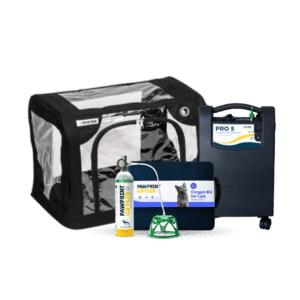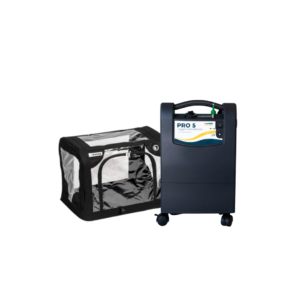Expecting a litter of puppies soon? Be prepared by having Pawprint Emergency on hand
Be prepared and make sure that each runt comes out happy and healthy. Keep rescue oxygen canisters or an oxygen concentrator on hand so that you will be ready if one of them is hypoxic and needs help fast.
The Inherent Risks of Having a Litter of Puppies
Caring for a litter of puppies, especially when some of them require oxygen, involves several risks and challenges. Being equipped with a home Oxygen solution like an Oxygen Chamber and Concentrator can prevent seperation of the puppy from its mother and increased Veterinary costs:
Underlying Health Issues: Puppies needing oxygen may have underlying health conditions such as congenital heart defects, respiratory disorders, or infections. These conditions not only necessitate oxygen therapy but may also indicate more complex health problems.
Oxygen Toxicity: While oxygen is life-saving, excessive or improperly managed oxygen levels can lead to oxygen toxicity. This condition can damage the lungs and other organs, particularly in newborns whose organs are still developing.
Difficulty in Feeding: Puppies with respiratory distress or those needing supplemental oxygen may have difficulty nursing. This can lead to inadequate nutrition and failure to thrive, necessitating additional interventions like tube feeding.
Inadequate Maternal Care: The mother may neglect puppies that appear weak or are separated for treatment. This can lead to a lack of essential maternal care, including warmth, grooming, and bonding.
Risk of Infection: Newborn puppies have immature immune systems, making them more susceptible to infections. The use of medical equipment like oxygen masks or tubes can increase the risk of exposure to pathogens.
Thermal Regulation Issues: Puppies, especially those with health issues, can struggle to regulate their body temperature. Additional care must be taken to ensure they are kept warm, without overheating, particularly if they are separated from their mother and littermates.
Stress and Behavioral Issues: The stress of medical interventions can impact the puppies’ early development. Prolonged separation from the mother and littermates, if required for treatment, can lead to behavioral issues later in life.
What is Hypoxemia in Dogs?
Hypoxemia, or low blood oxygen levels, is a major risk to the health of a newborn puppy. If left untreated, hypoxemia can lead to long-term health consequences and even premature death. Hypoxemia results when a puppy is not able to take in enough oxygen.
Symptoms of hypoxemia include blue tongue or gums, high respiratory rate, airway noises (wheezing, honking, squealing, or snoring), panting when breathing, fainting, shortness of breath and more. Having an oxygen source on hand, such as Oxygen Canisters or an Oxygen Concentrator, can help you to prevent hypoxemia in your newborn puppies.
Why should Dogs with Hypoxemia use Oxygen?
Essential for Cellular Function: Oxygen is crucial for the proper functioning of cells in the body. Without adequate oxygen, cells cannot produce energy efficiently, leading to reduced functionality of organs and tissues.
Preventing Organ Damage: Chronic low oxygen levels can lead to damage in vital organs such as the brain, heart, and kidneys. Providing supplemental oxygen helps maintain the function of these organs and prevent long-term damage.
Alleviating Respiratory Distress: Dogs with hypoxemia often struggle to breathe. Oxygen therapy can help alleviate the effort they need to make to breathe, providing relief from symptoms like panting, coughing, and lethargy.
Enhancing Healing and Recovery: Adequate oxygen levels are essential for healing. Whether a dog is recovering from an illness, injury, or surgery, oxygen therapy can aid in faster and more efficient recovery.
Improving Quality of Life: For dogs with chronic respiratory conditions, supplemental oxygen can significantly improve their quality of life. It helps them to breathe more easily, be more active, and enjoy a better overall wellbeing.
Supporting Cardiovascular Function: Oxygen is vital for heart health. In cases of hypoxemia, the heart must work harder to deliver oxygen to the body. Supplemental oxygen can ease this strain, supporting cardiovascular function.
Pawprint Oxygen offers a variety of options for providing oxygen therapy to newborn puppies:

Pawprint Oxygen Canisters
This is a lightweight, easy to use, portable option. Canisters are great to have on hand in case a puppy goes into immediate respiratory distress or needs to be transported to a nearby emergency practice. Each canister provides up to 20 minutes of oxygen therapy. This emergency transport oxygen aid can make or break a long travel trip to a healthcare facility. Shop Here to learn more about Pawprint Oxygen Canisters.

The Oxygen Concentrator
The Oxygen Concentrator works by drawing in room air and purifying it into oxygen gas (>90%). This oxygen gas can then be delivered to the puppy through a variety of administrator devices, such as the Pet Oxygen Mask or an Oxygen Cage. Learn more about Pet Oxygen Concentrators here

The Buster ICU Oxygen Cage
The Buster ICU Pet Oxygen Cage is another device used for effective oxygen administration. The Cage is preferred in situations where a puppy may require a longer period of oxygen treatment. For example, if a newborn is blue when coming out of their mother, the cage may be a good option for providing oxygen treatment to the puppy for a few hours each day during its first few days of life.

The PureVent Pet Oxygen Mask
The Purevent Pet Oxygen Mask is the preferred oxygen administration device for at-home use. It is easy to use and allows for safe and immediate oxygen administration to a newborn puppy. The Pet Oxygen Mask can be used with the Pawprint Oxygen Canisters or an Oxygen Concentrator.
-

EVA Travel Case for Pet Oxygen
$30.00 -
Sale!

Extended + Rescue Oxygen Therapy Bundle for Cats
$1,500.00 -
Sale!

Extended + Rescue Oxygen Therapy Bundle for Large Dogs
$2,300.00 -
Sale!

Extended + Rescue Oxygen Therapy Bundle for Small Dogs
$1,500.00 -
Sale!

Extended Oxygen Therapy Bundle for Large Pets, up to 70 lbs
$2,100.00 -
Sale!

Extended Oxygen Therapy Bundle for Pets, up to 10 lbs
$1,200.00

